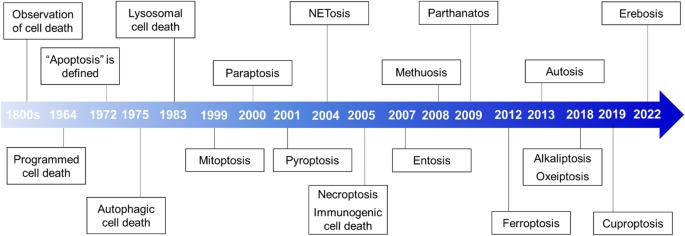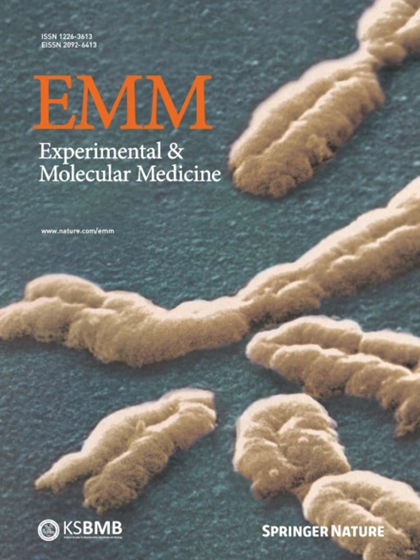细胞死亡的多样性和复杂性:历史回顾。
IF 9.5
2区 医学
Q1 BIOCHEMISTRY & MOLECULAR BIOLOGY
引用次数: 0
摘要
死亡是所有生物的必然命运,无论是在个体还是细胞层面。长期以来,细胞死亡被认为是无功能细胞不可取但不可避免的最终结果,因为炎症不可避免地会因损伤而触发。然而,过去几十年积累的实验证据揭示了不同类型的细胞死亡,这些细胞的基因程序是为了消除可能损伤周围组织的不必要或严重损伤的细胞。多年来,已经描述了几种类型的细胞死亡,包括凋亡、坏死、自噬细胞死亡和溶酶体细胞死亡,它们被归类为程序性细胞死亡,以及焦下垂、坏死和NETosis,它们被分类为炎症细胞死亡。近年来,人们发现了几种新的细胞死亡形式,即有丝分裂症、副有丝分裂病、免疫原性细胞死亡、内有丝分裂、甲基化、parthanatos、脱铁性、自体丝分裂、碱性丝分裂、氧化丝分裂、铜丝分裂和埃瑞博丝分裂,并加深了我们对细胞死亡及其复杂性的理解。在这篇综述中,我们对不同形式的细胞死亡的发现和表征进行了历史概述,并强调了它们的多样性和复杂性。我们还简要讨论了每种类型细胞死亡的调控机制,以及细胞死亡在各种生理和病理环境中的意义。这篇综述提供了对细胞死亡不同机制的全面理解,可用于开发各种疾病的新治疗策略。本文章由计算机程序翻译,如有差异,请以英文原文为准。

Diversity and complexity of cell death: a historical review
Death is the inevitable fate of all living organisms, whether at the individual or cellular level. For a long time, cell death was believed to be an undesirable but unavoidable final outcome of nonfunctioning cells, as inflammation was inevitably triggered in response to damage. However, experimental evidence accumulated over the past few decades has revealed different types of cell death that are genetically programmed to eliminate unnecessary or severely damaged cells that may damage surrounding tissues. Several types of cell death, including apoptosis, necrosis, autophagic cell death, and lysosomal cell death, which are classified as programmed cell death, and pyroptosis, necroptosis, and NETosis, which are classified as inflammatory cell death, have been described over the years. Recently, several novel forms of cell death, namely, mitoptosis, paraptosis, immunogenic cell death, entosis, methuosis, parthanatos, ferroptosis, autosis, alkaliptosis, oxeiptosis, cuproptosis, and erebosis, have been discovered and advanced our understanding of cell death and its complexity. In this review, we provide a historical overview of the discovery and characterization of different forms of cell death and highlight their diversity and complexity. We also briefly discuss the regulatory mechanisms underlying each type of cell death and the implications of cell death in various physiological and pathological contexts. This review provides a comprehensive understanding of different mechanisms of cell death that can be leveraged to develop novel therapeutic strategies for various diseases. Cell death is a complex and interconnected process that plays a crucial role in maintaining tissue homeostasis and preventing disease. There are various types of cell death, including necrosis, apoptosis, autophagy, and others, each with distinct morphological features and molecular mechanisms. Understanding the diverse processes underlying cell death is essential for understanding diseases and developing new therapies. Recent research has focused on characterizing and distinguishing various forms of cell death, thereby advancing our understanding of their roles in health and disease. The complex mechanisms underlying cell death are underscored by the intricate interconnections among different types of cell death and the regulation of these mechanisms through diverse signaling pathways and environmental factors. Further research is necessary to fully characterize and differentiate among the various forms of cell death and their roles in pathological conditions.
求助全文
通过发布文献求助,成功后即可免费获取论文全文。
去求助
来源期刊

Experimental and Molecular Medicine
医学-生化与分子生物学
CiteScore
19.50
自引率
0.80%
发文量
166
审稿时长
3 months
期刊介绍:
Experimental & Molecular Medicine (EMM) stands as Korea's pioneering biochemistry journal, established in 1964 and rejuvenated in 1996 as an Open Access, fully peer-reviewed international journal. Dedicated to advancing translational research and showcasing recent breakthroughs in the biomedical realm, EMM invites submissions encompassing genetic, molecular, and cellular studies of human physiology and diseases. Emphasizing the correlation between experimental and translational research and enhanced clinical benefits, the journal actively encourages contributions employing specific molecular tools. Welcoming studies that bridge basic discoveries with clinical relevance, alongside articles demonstrating clear in vivo significance and novelty, Experimental & Molecular Medicine proudly serves as an open-access, online-only repository of cutting-edge medical research.
 求助内容:
求助内容: 应助结果提醒方式:
应助结果提醒方式:


